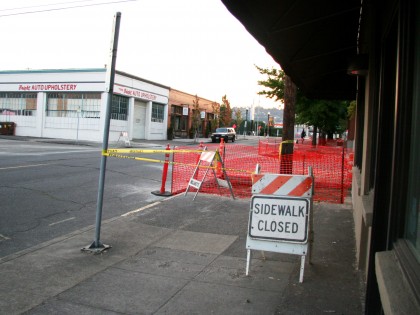Here in Portland, it’s been a summer of detours. And some of them are much better than others.
Let’s help the city make more of them good.
The Bicycle Transportation Alliance, fortunately, has noticed this problem. This Thursday, BTA intern Ruben Montes is hoping to meet with the City of Portland’s Mark Lear and Craig Goodroad to start looking for ways the city can better design construction zones to work for active transportation.
We’d love to give them some material to talk about. So for the next few days, any time you see a detour in Portland that doesn’t seem to prioritize human beings, or one that you think does so well, snap a photo and email it, with a few words about its location, to michael@bikeportland.org or text it to me at 503-333-7824.
Or if you’ve got an old photo from a past detour, that’s great, too.
We’ll select the best and worst examples and send them to the BTA and the city, and maybe publish them here in a follow-up post. Feel free to send, with the photo, an explanation of what you think could be better or why it works well, but you don’t have to.
Obviously construction is a fact of life, and sidewalks and bike lanes are going to be affected. But the problem isn’t that walkways are being blocked. It’s that detours give the city a choice to inconvenience either auto travel or foot travel — and auto travel usually seems to come out ahead.
Our little project was inspired by a smart note last week from Kirk Paulsen to the Active Right of Way Google Group. Paulsen, a recent PSU grad who’s recently joined Portland-based Lancaster Engineering, was frustrated by detours on the Broadway Bridge, Southeast Portland light rail construction, St. Johns Bridge, Cemetery detour and Steel Bridge that seemed to leave people on feet or bikes at the bottom of the heap.
Paulsen asked for advice on how transportation advocates can “work with / encourage local jurisdictions to make their detour plans work for active transportation from the beginning, instead of making it a ‘fight’ after the fact.”
“A recent trip to Chicago opened my eyes as to how an urban city that is making REAL & SUBSTANTIVE modern strides in becoming much more sustainable could teach us a lesson or two,” Paulsen wrote.
Here’s a detour from the middle of downtown Portland that Paulsen saw as failing to uphold the city’s stated priority to put foot transportation first:
Meanwhile, here’s one from downtown Chicago that sacrificed a bit of auto space in order to preserve the walking connection:
“Certain modes of travel [i.e. foot travel] absolutely have to give up some space during construction, and it is as if temporarily reallocating standard travel lanes is an untouchable subject,” Paulson wrote to the group. “Why aren’t our policies being implemented?”
Good question, Kirk. Some city detours are so thoughtfully built that I’m sure this is something the city could happily improve if they made a habit of it. With your help, we can help them develop that habit.




